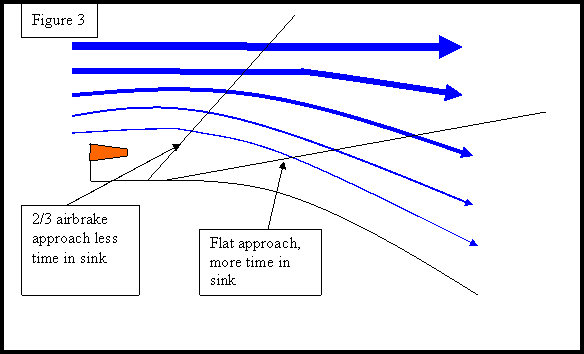Site Briefing
As you’ve probably already deduced, flying gliders at Talgarth in the Black Mountains might be a little different to where you normally fly. We have a small-ish airfield, in the mountains which presents us with some challenges. But for most glider pilots flying at Talgarth is well within their capability as long as they follow our rules and take note of the advice offered at our daily briefing.
These notes accompany our flying rules and are compulsory reading for anyone new to Talgarth.
The lack of restrictive airspace, long stretches of ridges, wave and great thermal flying gives us access to the stunning scenery of The Brecon Beacons national park and mid/north wales and borders.
Please read these notes and ensure that any other pilots in your group also do so.
It’s also a good idea to watch our video briefings.
Airspace restrictions
Make sure that you are familiar with the few airspace restrictions that apply to us:
Airway N684 passes directly overhead the site with its base at FL125.
Gliders are NOT allowed to fly in airways even under VFR. This means that gold and diamond height climbs must be made away from the airway. In practice, this is not a problem as the wave is usually present over large areas. The map in the clubhouse shows the details … learn them and respect them please!
When wave is extensive, the controlled airspace is high enough to allow cross country flying over all of central Wales and does not restrict a return to Talgarth.
When thermal flying, avoid the military training ranges of Sennybridge D203 and the SAS training area south west of Hereford D147. RAF low level fast jet training takes place most week days, but is mostly below 500 ft and follows the valleys.
Flying in the circuit
Circuit planning at Talgarth requires more thought than most other sites because it is a smaller site.
General Layout
The field slopes away from its Southern edge in all directions, like an upturned saucer.
The Southern edge has a tall hedgerow, trailer park and hanger. For this reason, it is generally better to fly your circuit on the North side of the field.
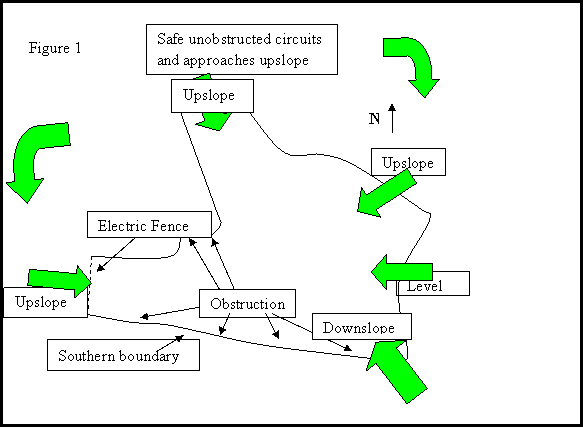
Turning in early options are much improved if you are on the North side of the field. From the north most approaches are up-slope with few obstructions. From the South most approaches are downhill with significant obstructions.
If you have to choose between landing downhill and into wind or uphill and downwind, choose to land up the slope.
Take off
Please be well prepared, get your checks done in good time. You will not be thanked for unnecessary delays.
Radio checks are on 118.685. The tug pilot will happily oblige. Your call should be – Papa Alpha, followed by your call sign, radio check please.
Often you will find you are taking off down slope. This is good news for take-off performance, but can also catch the unwary.
- If the ground is firm you may roll forward after the slack has been taken out of the rope. Watch out for this; if the signaler has not spotted it pull off. Top tip; if you have a wheel brake use it. If your wheel brake is at the end of the airbrake travel you should advise the tug pilot you plan to hold the glider on the brakes and will close them when rolling.
- Be prepared to follow the tow plane downhill, do not allow yourself to get too high.
Eventualities
There are several good fields in the valley, but do not rely on any particular field being available to you—farmers do move sheep around!
Your pre-take off check should include:
- Wind direction and likely orientation of a landing field.
- What landing directions are acceptable today, should a safe return to the field be possible.
- What is your approach speed for today’s conditions?
Take off directions
“From the Gate” is the main entrance to the field. The preferred take off direction is “from the gate” in a north westerly direction. This is downhill heading towards the valley to give you an easy escape route in the event of a rope break. It also avoids crossing the road to the farm.
“From the hedge” heading due west is the second choice. It is slightly uphill to start with and crosses the road to the farm. In winter the take-off area is rather soft but is otherwise quite a good run.
The north east take-off is not shown as this is only used in strong winds and needs an individual briefing.
On Tow
The tow-plane will fly towards the mountain. Which obscure the natural horizon, maintain your position with reference to where the tow plane appears on the canopy.
When approaching the mountain your task is to remain in station behind the tug.
On release, be absolutely certain the rope has gone. Wait and see it go, the tug may be within close proximity of the hill, and would prefer not to be tipped towards it. Once sure, make a climbing turn, the tug will descend away from the hill.
Return to the airfield
When approaching from the South, the field can be difficult to spot; the trailers are screened by the hedgerow. If in doubt locate Y Das and Talgarth hospital, the airfield is between the two and will become more obvious as you get closer.
Always check the windsock before deciding your landing direction. Wind conditions change more frequently in hilly areas.
Listen out on the radio; other gliders will often make a radio call when downwind in the circuit; this will help your situational awareness. If it is busy, you may decide to continue soaring until the rush is over.
Landing
Circuits are to the north and west of the field because that makes you visible from the launch point and gives you several running out of height options.
Landing South West*
This is the preferred landing direction. It provides the longest ground run which is helped by the slight up-slope at the threshold. New pilots are often concerned about landing towards a hedge and aided by sink on the approach, land too short until they get used to the field.
Landing South East*
Similar to above, can be a good option if low for SW or to avoid a conflict on the airfield.
Landing West
“Over the hedge” – With a moderate wind from the north west, we favour landing through the large gap in the trees on the west runway. This is straightforward but, obviously, there is no undershoot. A cross wind on this runway is preferable to the short north west runway with its downward slope.
Landing North West
Landing in this direction, over the entrance gate and should only be attempted by experienced pilots in a wind which exceeds 20 Kts.
Landing East*
Try and touch down at or before the road and run on past the clubhouse where there is more space for following aircraft. There is sometimes an electric fence raised on the threshold of the east runway. The field short of the threshold, can be used in an emergency. Watch for cars or people on the road that crosses the airfield and try not to stop before the road as this blocks the field for following aircraft. Landing east is a good option in calm weather.
North East
The North East runway is never used for landing, use the east runway and accept the cross wind.
* When landing on the east, south west or south east runways, care should be taken to touch down after the white markers.
Considering the wind
Hill sites can suffer from 3 different wind characteristics.
- Wind gradient
- Clutching hand
- Turbulence/low level wind shear.
Wind gradient is caused by friction with the ground, resulting in higher winds aloft and a progressively weakening wind as we descend. A dynamic loss of airspeed is to be expected in a wind gradient, and extra speed is required to provide a safety margin.
Clutching hand is caused by the airflow following the contours of the ground. The closer to the ground, the more pronounced the downward vector becomes. Even relatively light winds can produce significant sink as you approach the lee of a slope. Any uphill landing at Talgarth has a potential for clutching hand, (Figure 2)
Turbulence is caused by the airflow being disrupted in some way, trees and buildings are the most common causes. Wave rotor is the primary cause at Talgarth. Easterly wave can cause severe turbulence, and take-offs with a southerly wind can be affected by turbulence off the trees.
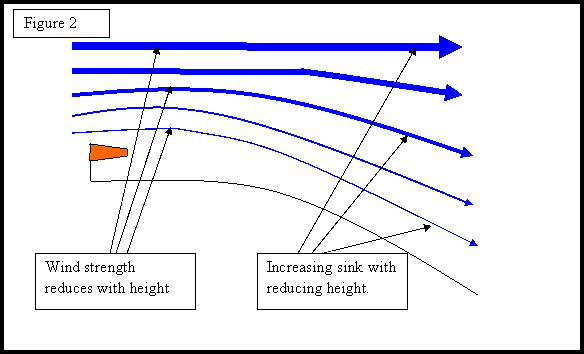
Intercepting and maintaining a 2/3 airbrake approach ensures the risk of a late undershoot minimised, because airbrake can be reduced if necessary at the latter stages of the approach. (Figure3) It also keeps you out of the worst of the clutching hand. If you get caught in clutching hand it is absolutely relentless and goes all the way to the ground—if you do get caught, increase speed, get into ground effect, do not attempt to stretch the glide.
Downwind Leg
The landing direction is rarely the same as the take-off direction; the anticipated landing direction is provided at the morning briefing. It is still your responsibility as the pilot to check the windsock and review the landing direction.
The downwind leg is parallel to the approach direction. Many pilots get too cramped because there is no obvious line to follow. Try to visualise an extended runway (a line running across the country side and use that line as your guide. This diagram shows the general idea for the Southwest approach (Runway 23).
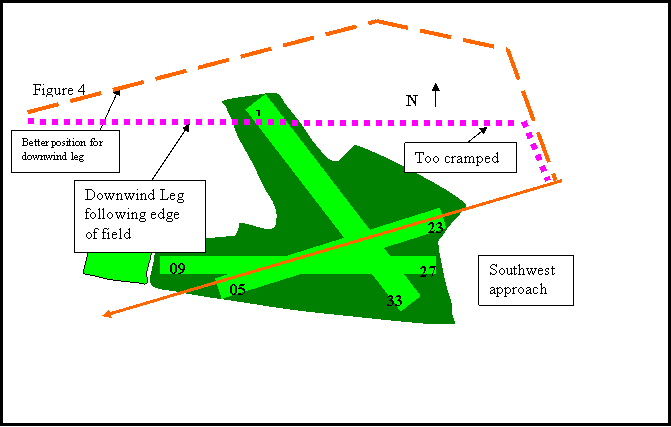
When judging your circuit remember that the terrain around the airfield varies in height. Some features (Y Das) are higher than you. Remember your basic training and judge the angle between yourself and your reference area, other factors may be deceptive.
Radio call
It is preferred to make a radio call early on the downwind leg., if you are too busy, concentrate on the flying and leave the radio.
Use 118.685 MHz , e.g. “Talgarth traffic—your call sign—downwind—right for South West”
If another glider is in circuit indicate your position in landing order. – Talgarth—your call sign—downwind right for South West —number two.
DO NOT WORRY ABOUT THE EXACT WORDING.
The approach
Most approaches are up-slope, add 5 knots extra to allow for the round-out.
The markers are very important; only plan to land after them. On 23, they indicate a significant change in slope, on 09 they mark the line of the electric fence.
The up slope can be deceptive, you may feel too high, watch for under or over shooting.
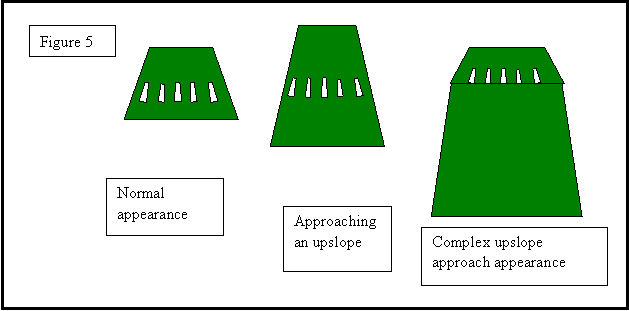
You will notice that the complex slope makes the markers look a disproportionate distance into the field, you should only be interested in the apparent vertical movement of the markers, not the distances. Sub consciously there is a risk you will want to land short—after all who would want to waste all that land-able area in an already small field!!
The ground run
- If you can land long it is always appreciated. But make sure you are safely in the field first.
- When you come to a stop, get the glider moved as your first priority, chat about your great flight afterwards.
I hope you enjoy your flying at Talgarth. Keep it safe, and we will enjoy your visit too.

